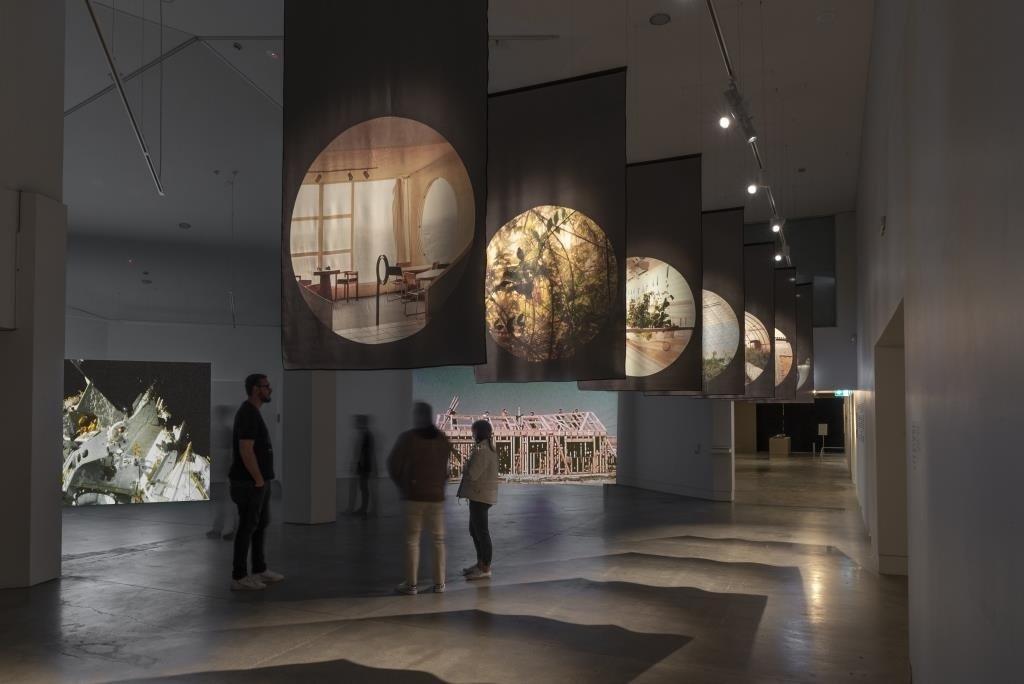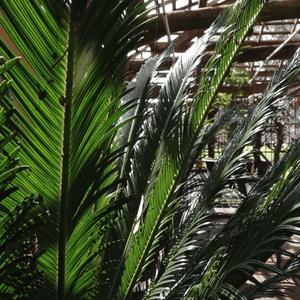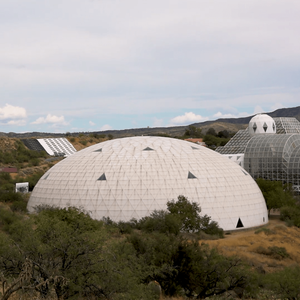Image and text, when brought together in an artwork, often operate in one of two categories: either images illustrate words, or words caption images.
Since their first collaboration in 2004, Fiona Amundsen and Tim Corballis have pushed against this dynamic and explored alternatives in which language and lens respond to and espouse one another. Their practice is one of parallax, of “crossing wires that usually do not touch” to find aspects un-thought and lesser-considered and to thereby expand the scope of the work.(1) Foremost, however, they commune in their shared resolve to ask rather than answer questions, and to listen intently for and to the response. With their shift from static into moving image formats, this methodology has persisted and evolved, as demonstrated by their latest project, Human Hand.
The exhibition, presented at the Dowse Art Museum in Lower Hutt, seeks to gain a sense of how worlds get built and how they might be built differently were we more gentle and considered in our handling of them. It locates touch in the places it seems most absent: places of immensity, where the world seems too large as to ever have been held and formed; of complexity, where history is annotated so extensively that its margins burst their banks; and of atrocity, where those histories feel too fleshly, from which any lingering trace of our touch is neurotically buffed out.
They explore this idea through three neighbouring sites in Arizona which they visited and documented throughout 2019. Each represents a micro-world, built purposefully to serve and embody specific though much varied theories, hypotheses and imperatives. At this small scale and within these slender niches, the artists hoped to short-circuit the largeness that obscures our understanding of world-building at a wider scope. “Each site,” they write in an accompanying text, “[was] separate from the world and a mirror of it,” and a concentration of its forces.(2) In other words, each site represents what Michel Foucault, in his famed essay Of other spaces, would describe as a garden, that is, a space that is “the smallest parcel of the world,” as well as its absolute totality.(3)
These spaces comprised Arcosanti, a micro-city conceived by the architect Paolo Soleri in the 1970s as an urban environment that would reconcile social and economic life with ecological systems, Biosphere 2, an experiment modelling potential human settlement on Mars through the recreation of Earth’s essential systems within a geodesic dome, and finally, the Titan II Missile Museum which served as a centre of the US military’s nuclear offensive during the Cold War.
The artists present their experience of Arcosanti, Biosphere 2 and Titan II through three video works combining footage shot and compiled by Amundsen with text written by Corballis and excerpts from interviews conducted at the sites. Respectively these are Social Bodies, To Stay Alive and Command Performance. They also include a series of silk screen print photographs, designed to hang like military banners from the Dowse’s high ceilings.
Though lens and language are folded snugly together in the works, the three-chambered arrangement of the gallery space lends an immediate prominence to Amundsen’s distinctive visual aesthetic and ethic. As in recent independent projects such as A Body That Lives (2017) and To Each Other (2016), the works combine archival documentation with the artist’s original footage. This is, by now, a much-practiced style within Amundsen’s repertory; over the years, she has sharpened the apparent blank formalism of her own lens into a fierce needle-point which, when pressed against historical images, serves to undress, incise and dissect them.
Command Performance (2020) Fiona Amundsen & Tim Corballis
In Command Performance, hulking steel missiles engulf the frame among archival shots of production lines, test launches, radar displays and primitive drone technology. But for all its incising and dissecting and nuclear weaponry, the work maintains a calm posture. Amundsen is not really one for haste or spectacle; instead, looking motionlessly at or quietly panning around the structures, her images point the viewer towards their details. A panel indicating the position of the missile’s "Telemetering Umbilical 2Bit", for example, struck me—cruelly and comically evoking the idea of birth in this steel chamber where I would have preferred to think uniquely of Armageddon.
In the essay that accompanies the exhibition, the artists cite “an attitude of sensitivity and listening” and faith in the notion that “there is more in the recorded voice than just words, just as there is far more in the photograph than just evidence” as its two main premises. These are also the things that unify their concerns as artists and structure their collaboration. Thinking uniquely of one thing is therefore not the requested viewing mode.
When they speak of this "something more" in words and images, they’re speaking of gestures, mannerisms, intonation, texture, appearance and vernacular as these things punctuate the expressions of history and of individual people. They’re speaking of silences and outbursts, and the things that prompt them.
Layering and colliding their separate practices signals to all of this where it exists within, underneath and beyond what is seen. Unlike in their early projects which used photographs, requiring viewers to move between text and image, the moving image form presents an opportunity for simultaneity, wherein the elements can be—must be—encountered at once. At the same time that this brings the shared rhythms between image, text and voice to the fore, it also breaks open the subjects they describe, extruding their molten details, demanding greater attention and care from the viewer as the innards bubble, surge and drip down the works’ flanks.
Arcosanti, Biosphere 2 and Titan II all seethe with such details. All seem to have been pulled from the great heavy sack that Ursula Le Guin described in her "Carrier Bag Theory of Fiction", wherein stories are “full of beginnings without ends, of initiations, of losses, of transformations and translations, and far more tricks than conflicts, far fewer triumphs than snares and delusions; full of space ships that get stuck, missions that fail, and people who don't understand”.(4)
When thinking about the history of a place, person or world, this is the stuff we tend to move away from and whittle out: the confusing, the minor, the abject, the stuff that is, more often than not, the product of the human touch.
Human Hand, however, argues that this is the very substance from which a world is formed.
Setting edits to such poetic obscurities as “the image of the missile stays with us, underground and pointing toward a half-open door,” or “we wondered if we could feel how the shape felt,” as offered by Corballis, the works grant us access to this substance. The interviews and passages read atop of the works do the same.
Social Bodies (2020) Fiona Amundsen & Tim Corballis
It’s a viscous, barbed thing, this substance; it clings to our feet, snags on our clothes and slows our pace to an ungainly trudge. But there is value in allowing oneself to be snagged and burdened by history. Amundsen’s practice has long contended this, and in this work, she has found lucid endorsement of it in the philosophy of activist, author and Buddhist teacher, Joanna Macy. Drawing in equal parts from her spiritual and scholarly background to think about present ecological circumstances—and their psychological contingencies—Macy offers that, “as in all organisms, pain has a purpose: it is a warning signal, desired to trigger remedial action. The problem, therefore, lies not in our pain for the world but in our repression of it”.(5) Too often, she is saying, the traces of history are impalpable, or we treat them as such, like a fine clay dust that we are constantly and ignorantly breathing in, even as it forms a fatal crust in our lungs. Or like radiation in our soils and oceans.
This prelude shows our dull suburban domiciles to be, at their core, an expression of military logic, which is just one strange way that everyday reality and grand ideas co-exist in the exhibition.
Each video opens with Macy’s voice reading a text written by Corballis outlining how US cities were designed to minimise their vulnerability to an enemy offensive, designed in anticipation of attacks like those the country had itself effected in Germany and Japan. “It’s not just that a bomb could take out a vital factory. It could take out a whole city, and destroy all the factories in that city,” she recounts, “So American planners started to think about how to disperse the different vital industries, to take them away from the centre of the city, spread them around.”
This prelude shows our dull suburban domiciles to be, at their core, an expression of military logic, which is just one strange way that everyday reality and grand ideas co-exist in the exhibition. Similar entanglements are present in each of the sites. Arcosanti imagines life-giving harmony and Titan II prepares for apocalypse and Biosphere 2, somehow, seems to do both things. Yet despite the great ideas and ideals that had initially driven their construction, all contained an everyday reality that was commonplace and consuming.
In To Stay Alive, there is an anecdote read regarding the library at Biosphere 2. This library was situated at the top of turret-like, specially-designed structure, but was almost never used by the crew because they were so busy and tired from tending to their basic needs and those of the dome’s many systems. “It’s easy to imagine that they weren’t obsessing over the ideas really, not usually,” the speaker concludes from this anecdote, “They weren’t thinking about the planet and its spheres, they were just doing the jobs that were in front of them.” In other words, they were distracted by their lives in the way that we all are. They were probably not listening to the intonations or watching the gestures or taking note of the texture, and they, too, were breathing in the dust.
Finding touch in these places where it seems most absent but is always present, Fiona Amundsen and Tim Corballis offer us an awareness of these spaces—and by extension, the world—as these immense, complex and, to varying degrees, atrocious things that are nonetheless made. With this awareness, the artists also offer the suggestion, or the challenge, that in attending fully to these processes the world might be undone and redone through means just as simple: through sleights, and slips, of hand, through pressing the bruise and registering the pain.


